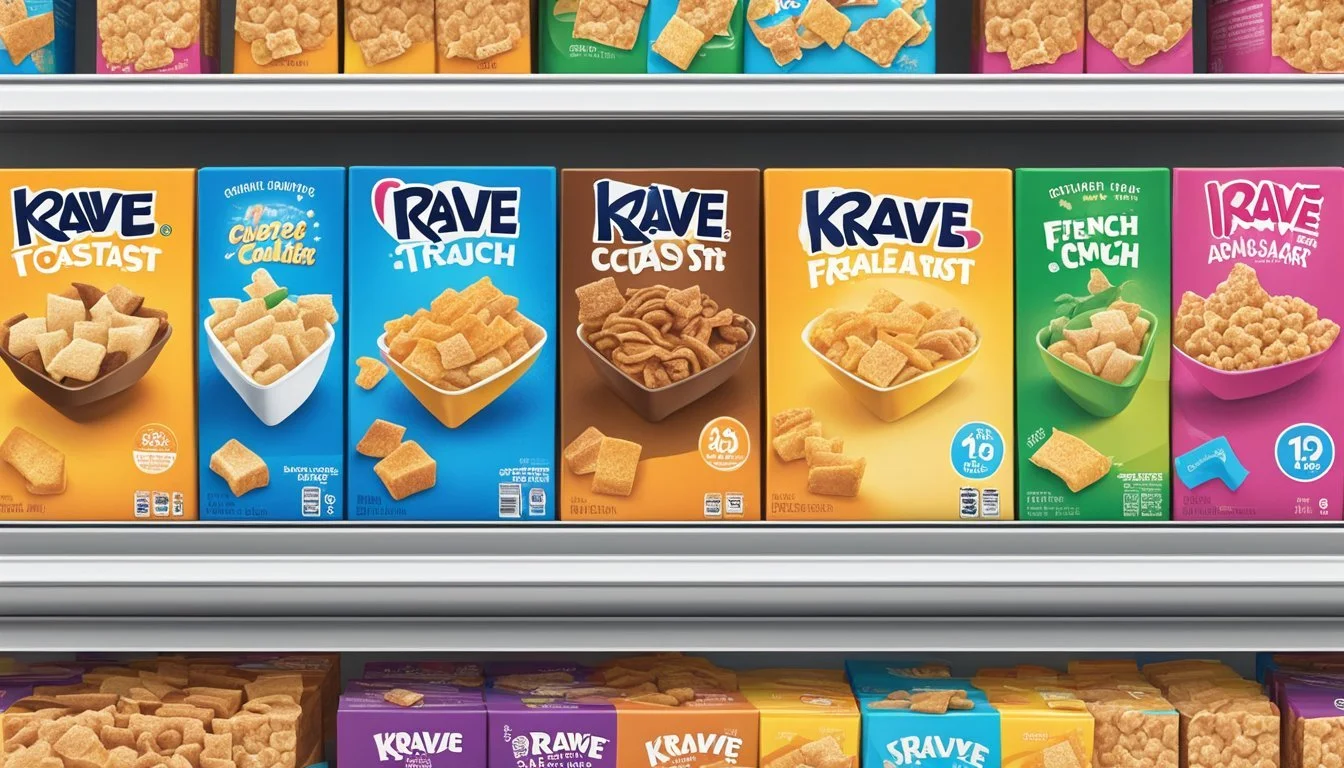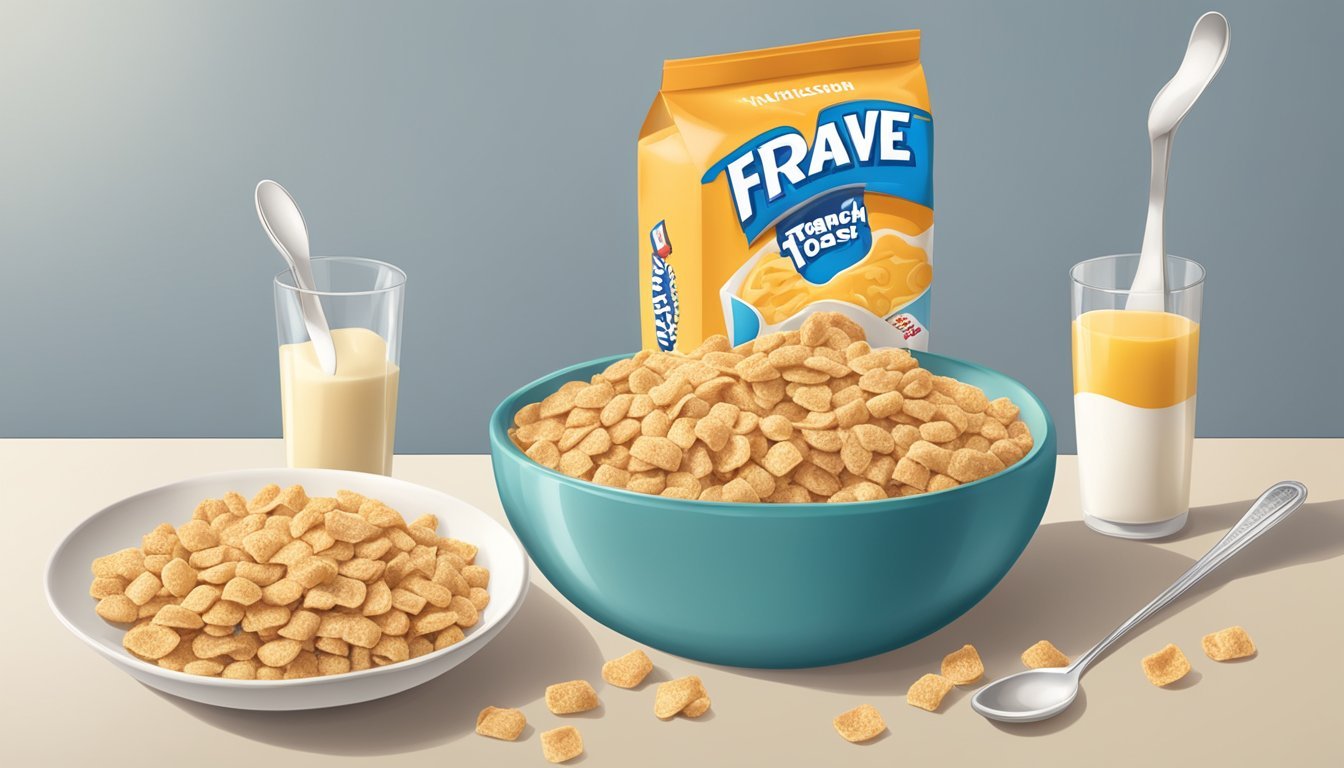French Toast Crunch vs Krave
Comparing Breakfast Cereal Favorites
This Article is Part of Our Breakfast Cereal Guide with Details on French Toast Crunch Nutrition and Krave Nutrition
In the vibrant world of breakfast cereals, two contenders often spark debate: French Toast Crunch and Krave. Each brings unique flavors and textures to the table, appealing to different palates. While French Toast Crunch delivers a nostalgic, cinnamon-infused experience reminiscent of homemade French toast, Krave offers a modern twist with its chocolate-filled bites.
For health-conscious consumers, French Toast Crunch tends to have fewer processed ingredients compared to Krave. This could be a deciding factor for those wary of their sugar intake and artificial additives. Nonetheless, Krave's daring inclusion of actual chocolate pieces is a significant draw for chocolate lovers seeking an indulgent start to their day.
Despite varying opinions on sweetness and ingredient lists, both cereals occupy a special place in breakfast culture. Whether someone craves the comforting simplicity of cinnamon or the rich decadence of chocolate, the choice between French Toast Crunch and Krave ultimately depends on personal preference.
Overview of French Toast Crunch and Krave
The breakfast cereals French Toast Crunch and Krave each have distinct histories and flavor profiles that appeal to different tastes. This section explores their origins and key components.
History and Evolution of the Brands
French Toast Crunch was introduced in the mid-1990s by General Mills. Initially, the cereal pieces resembled miniature slices of French toast. Over time, the shape changed to thin, wavy squares similar to Cinnamon Toast Crunch.
On the other hand, Krave was launched by Kellogg's in 2012. Known for its filled cereal pieces, Krave quickly gained popularity among those seeking a chocolate-filled breakfast option. The brand expanded with variations including double chocolate and other flavors.
These cereals have evolved to meet changing consumer preferences, with French Toast Crunch reintroducing its original shape by popular demand and Krave adding new flavors.
Key Ingredients and Flavor Profiles
French Toast Crunch features pieces made from corn and wheat, flavored with cinnamon and sugar to mimic French toast. It contains no high fructose corn syrup or artificial flavors, making it a nostalgic yet relatively simple treat.
Krave is known for its crispy outer shell and creamy chocolate filling. Made primarily from wheat and rice, it offers a sweeter, richer taste compared to French Toast Crunch. Krave's higher sugar content and distinctive chocolate flavor cater to chocolate lovers.
Both cereals provide unique taste experiences leveraging their distinct ingredient lists to cater to differing breakfast preferences.
Nutritional Comparison
When comparing French Toast Crunch and Krave, key nutritional factors such as caloric content and serving sizes, as well as protein and fiber content, stand out. By examining these specifics, readers can make informed choices about their breakfast meals.
Caloric Content and Serving Sizes
French Toast Crunch:
Per serving (3/4 cup): approximately 120 calories
Contains sugars and carbohydrates which contribute to its high energy content
Made in smaller serving sizes, which might necessitate multiple servings to feel full
Krave:
Per serving (1 cup): approximately 190 calories
Slightly larger serving size than French Toast Crunch
Higher calorie count but provides a richer nutrient profile including antioxidants and vitamins
Balancing caloric intake with the right serving size is important for maintaining a healthy diet, making it crucial to consider these factors when choosing between the two.
Protein and Fiber Content
French Toast Crunch:
Protein: Low, around 1g per serving
Fiber: Minimal, approximately 1g per serving
Sugar: Higher, adding to its sweeter taste
Whole Grains: Not a significant component
Krave:
Protein: Higher, around 5g per serving
Fiber: Similarly low, approximately 1g per serving
Sugar: Slightly lower than French Toast Crunch, contributing to its balanced taste
Whole Grains: Incorporated, enhancing the nutritional value
Evaluating protein and fiber content shows Krave as a healthier breakfast option due to its higher protein levels, which support muscle growth and satiety, although both cereals lack sufficient fiber to be classified as high-fiber options. The presence of whole grains in Krave also enhances its role as a nutritious breakfast choice.
Texture and Taste Experience
Exploring the texture and taste of French Toast Crunch and Krave reveals differences in both crunchiness and flavor duration when immersed in milk. Each cereal offers a distinct sensory journey, influenced by its core ingredients and design.
Crunchiness and Consistency with Milk
French Toast Crunch maintains a hearty crunch even when soaked in milk. The pieces are small and consistent, ensuring a balanced texture. Each bite is reminiscent of actual French toast with a sugary coating that doesn’t disintegrate quickly.
In contrast, Krave features a softer texture with a center that melts more rapidly in the mouth. While initially crunchy, Krave’s shell is thinner, causing it to soften faster in milk. This change in consistency provides a varied textural experience during consumption.
Cinnamon Toast Crunch, known for its robust crunch, serves as a comparison point. Both French Toast Crunch and Krave provide enjoyable textural features tailored to different preferences.
Flavor Longevity in Milk
When it comes to flavor retention in milk, French Toast Crunch excels. The cereal retains its cinnamon and syrupy flavor throughout the eating experience. Each piece is designed to imbue the milk with a subtle sweetness, enhancing the overall flavor profile until the last spoonful.
Krave, on the other hand, offers an intense burst of flavor upfront with its rich, chocolatey filling. The exterior’s cinnamon notes blend with the milk, but the flavor may not last as long as French Toast Crunch.
The flavor dialogue between cinnamon sugar and chocolate in Krave can be compared to the lasting cinnamon presence of Cinnamon Toast Crunch. While different in profile, both cereals provide unique and enjoyable flavors that engage the palate.
Variety and Availability
French Toast Crunch and Krave offer distinct experiences in their flavor profiles and market distribution. Their availability and reception among consumers highlight differences worth noting.
Different Flavors and Limited Editions
French Toast Crunch is known for its classic cinnamon and syrup-flavored pieces, reminiscent of the breakfast favorite. It comes primarily in its original flavor, although it has seen various limited-edition releases over the years, reflecting seasonal or promotional themes. Krave, on the other hand, has a more diverse flavor lineup. Beyond its original chocolate-filled variant, Krave features options like Double Chocolate and S’mores, catering to various taste preferences. Seasonal editions intermittently expand the range, offering consumers something new and exciting.
Market Availability and Popularity
French Toast Crunch experienced discontinuation around 2006 but returned due to consumer demand, indicating its strong fan base. It's now available widely across major retailers in the U.S. Krave, a relatively newer player by Kellogg's, enjoys broad distribution in supermarkets and online stores. Its popularity owes to its unique filled-cereal concept, appealing to both children and adults. The market visibility of Krave's cinnamon crunch variant also adds to its draw, especially for those seeking a blend of chocolate and spice.
French Toast Crunch and Krave's varying degrees of accessibility and distinctive nature make them stand out on shelves.
Consumer Perceptions and Brand Loyalty
Consumer perceptions of French Toast Crunch and Krave differ in significant ways, affecting brand loyalty over time. Key factors include customer reviews, trends, and marketing strategies.
Reviews and Consumer Trends
Consumers often praise French Toast Crunch for its nostalgic flavor and unique texture, reminiscent of homemade French toast.
Krave, on the other hand, is noted for its bold taste and chocolate-filled centers, catering to those with a sweet tooth.
Review analysis on social platforms and retail websites shows a divide: French Toast Crunch appeals more to those seeking comfort foods, while Krave attracts younger demographics looking for something novel and exciting.
Loyalty is influenced by these perceived product strengths, with fans frequently repurchasing based on initial positive experiences.
Brand Marketing and Appeal
French Toast Crunch leverages nostalgia in its marketing campaigns, often using retro-themed advertisements that resonate with customers who enjoyed the cereal during childhood.
Krave focuses on bold, energetic marketing, often featuring animated characters and scenarios that highlight its daring flavor profile.
Both cereals use social media platforms to engage directly with consumers, yet their tone and style differ significantly.
French Toast Crunch emphasizes family-friendly content, while Krave's marketing is edgier, often incorporating humor and contemporary cultural references.
This strategic branding approach plays a critical role in shaping consumer perceptions and driving brand loyalty.
Comparative Analysis
French Toast Crunch and Krave stand out in the breakfast cereal aisle due to their distinct flavors and unique marketing strategies. Each brings a different taste experience and appeals to varied consumer preferences.
Comparisons With Similar Cereals
French Toast Crunch offers a nostalgic flavor reminiscent of the classic breakfast dish. Its key rivals in this flavor profile include Cinnamon Toast Crunch. Both these cereals emphasize the sweet, cinnamon-filled experience but differ in texture and nostalgia-driven branding.
Krave, on the other hand, caters to chocolate lovers. Its closest competitors are cereals like Cocoa Puffs and Lucky Charms chocolate version. Krave differentiates itself with a creamy filling, setting it apart from the straightforward chocolatey crunch of its competitors.
The texture and eating experience also contrast sharply. French Toast Crunch tends to stay crispy in milk, maintaining its bite longer. Krave features a dual texture with a crunchy shell and a softer interior, which can rapidly change in milk, offering a unique mouthfeel.
Positioning in the Breakfast Cereal Market
French Toast Crunch leverages nostalgia, attracting consumers who remember its first launch in the 90s. Positioned as a novelty cereal, it benefits from periodic re-releases, creating a sense of exclusivity and demand.
Krave appeals to a younger demographic seeking indulgence in their breakfast choice. With flavors like Chocolate Chip Cookie Dough and Double Chocolate, it markets itself as a more sophisticated, dessert-like cereal.
Both cereals use distinctive packaging to stand out. French Toast Crunch employs bright colors and the iconic French toast shapes on the box. Krave opts for a modern design, often showcasing the creamy filling to highlight the indulgent experience.
Strategically, French Toast Crunch fits into the family-friendly niche, while Krave targets a broader age range, especially teens and young adults, with its bold flavors and modern appeal.
Impact on Health and Diet
French Toast Crunch and Krave are two popular breakfast cereals that vary significantly in their nutritional profiles. While both can fit into a balanced diet, they offer different benefits and drawbacks in terms of nutrient content and suitability for various dietary needs.
Influence on Daily Nutrient Intake
French Toast Crunch is known for its high carbohydrate content, providing quick energy in the morning. A typical serving includes 32.2 grams of carbs. However, it lacks significant amounts of protein and fiber, which are essential for sustained energy and digestive health.
Krave, particularly the Cinnamon Crunch variety, is rich in sugar but also provides some protein and fiber. For example, a serving of Krave might offer 5 grams of protein and a small amount of fiber. Despite its higher sugar content, the inclusion of fiber can help moderate blood sugar spikes.
Appropriateness for Various Diets
French Toast Crunch may appeal to those seeking a sweet, energizing breakfast but may not be ideal for those following a high-protein or high-fiber diet. Its higher carbohydrate load might be unsuitable for low-carb diets.
Krave, with its mix of protein and fiber, can be a better option for those needing a more balanced macronutrient profile. However, its higher sugar content could be a concern for individuals managing their sugar intake or those on low-sugar diets.
By carefully considering the nutritional content and dietary suitability, consumers can better choose the cereal that aligns with their health goals.
More on French Toast Crunch
Cinnamon Toast Crunch vs French Toast Crunch: Which is better?
French Toast Crunch vs Kellogg's Apple Jacks: Which is better?
French Toast Crunch vs Kellogg's Froot Loops: Which is better?
French Toast Crunch vs Post GrapevsNut Flakes: Which is better?
French Toast Crunch vs Post Raisin Bran Cereal: Which is better?








